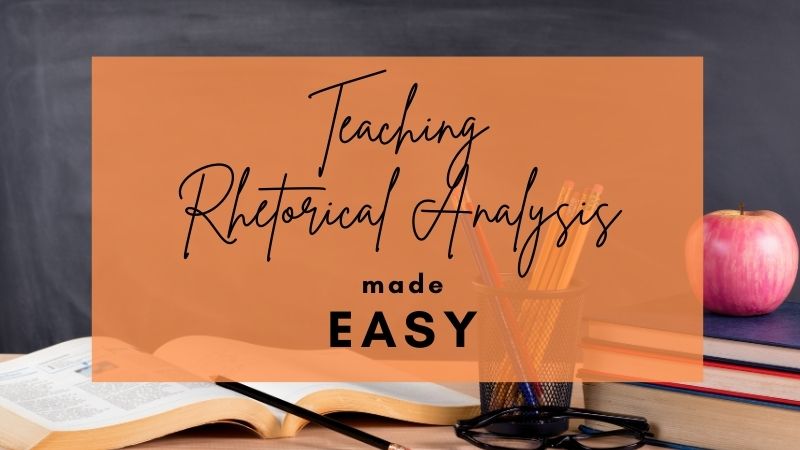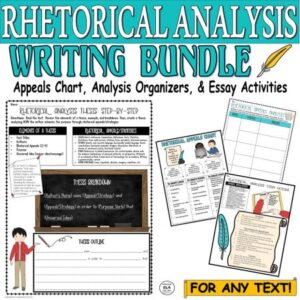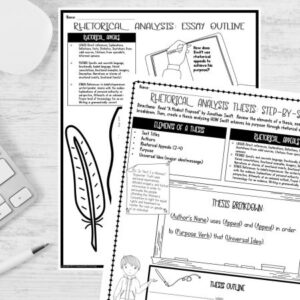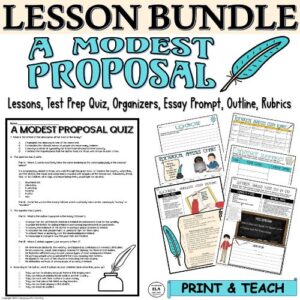Teaching Rhetorical Analysis is not always easy! In fact, I think it is one of the toughest types of writing for high school English teachers to teach! There seem to be a ton of rubrics out there for students to use, but rubrics are so difficult to break down. They might help students as checklists for when they have already written something, but how are students supposed to just start writing a rhetorical analysis essay?
Our high school students need a guide. As soon as they master writing rhetorical analysis essays, they can “break some of the rules” for writing. Until that time arrives, we need a basic writing structure that ALL students can use to help them develop their writing! A focus for each paragraph will help with just that!
Need help with Test Prep? Check out this FREE Pack of 3 Test Prep Activities to help students achieve success on standardized tests!
3 Different Ways to help with Teaching Rhetorical Analysis
1. Focus on Strategies
The purpose of writing a rhetorical analysis essay is to examine HOW the author gets his or her views across effectively! One avenue for thinking about effective writing is to analyze various strategies. After years of reading rhetorical analyses, I am amazed by the breadth of strategies available. And sometimes, there is no one right name to call a strategy.
Something could be a comparison or a metaphor. One could say an author is using a factual tone or using facts or writing with factual language. I really don’t think the specific name matters, unless the identification is completely wrong. For example, a student could say that someone is being “hyberbolic” to describe this phrase: “bite the bullet.” In this instance, there is no actual biting of any bullet, so hyperbole would not apply.
***Just as a side note, please know that when we say HOW, we mean that the author specifically uses strategies, devices, techniques, etc. in a purposeful way! They are pretty much all the same thing. Simply stated, they are tools for the writer or the rhetor.
We all have certain tools in our toolbelt when teaching rhetorical analysis, and our students need to know about these tools as well. They probably could tell you about a few they have learned of over the years, but they may not realize that these tools are used every day.
MY FAVORITE STRATEGIES TO USE WHEN TEACHING RHETORICAL ANALYSIS:
- Repetition: use of repeated words, phrases, sentences, and ideas
- Metaphors: comparison of two unlike things without using like or as
- Simile: comparison of two unlike things using like or as
- Tone or Shifting Tones: the emotion expressed by the author
- Imagery: description that appeals to the five senses
- Understatement: meaning less than what you intend
- Hyperbole: extreme exaggeration
- Irony: purposeful contradictions using opposite language or situations
- Rhetorical Question: asking a question the audience knows the answer to spark critical thinking
- Logos: an appeal to the audience’s rational thought by using facts and statistics
- Pathos: an appeal to the audience’s emotions through the use of emotional language
- Ethos: an appeal to the audience through a belief in the speaker’s authority or credibility
Want a Rhetorical Analysis Writing Pack you can use to make Teaching Rhetorical Analysis SIMPLE? Click HERE or below to buy!
Does teaching rhetorical appeals sound a bit overwhelming? Click to read “Rhetorical Appeals Definition: Logos Analysis in the High School Classroom!”
2. Focus on Structure
I have read so many Advanced Placement English Language and Composition (AP Lang) essays, and over time, I started to see a pattern. Many of the highest-level writers would hyper-focus on the structure of the rhetoric.
They would write each of their body paragraphs with a focus on a different part of the text.
For example, in the first body paragraph, the student might analyze how the writer begins.
A student might ask himself/herself the following:
- Why did the author start with this word or phrase?
- How did the author address the audience or the reader?
- Where does the author put certain words, phrases, or sentences?
- Do I notice any strategies that were effective especially at the beginning?
By teaching rhetorical analysis and analyzing a text this way, it forces the student to go above and beyond the typical rhetorical analysis I receive. Starting off with a focus on strategies is a great idea because it eases new or more struggling writers into this type of writing, but a focus on structure really highlights a student writer’s sophistication of thought!
If you want to give your students a challenge, have students start to think about structure. HOW an essay or piece of rhetoric is organized can be a strategy in and of itself.
There is a reason many authors start with a story, description, question, etc.
And maybe, you could have your students think about how they structure their own writing as well 🙂
Have you thought about teaching rhetorical analysis for “A Modest Proposal” by Jonathan Swift? Check out this lesson pack to make your job EASY and the work FUN for your students!
3. Focus on Ideas
This one, I think, can be the most difficult of all of the types of rhetorical analysis essays. Your students not only have to think about the strategies used; they also have to think about organizing their own essays with a focus on meaning and purpose with a singular idea for each body paragraph.
Let’s say, you are teaching rhetorical analysis for Ain’t I a Woman? by Sojourner Truth?
She is writing for 2 causes, which according to her are “women’s rights and Negroes’ rights!”
In teaching rhetorical analysis for this AMAZING and RELEVANT speech, you could have students write only 2 well-developed paragraphs. Each could focus on 1 of these 2 purposes.
Plus, your students will LOVE you for not having them write a traditional 5 paragraph essay 😉
Additionally, you could start out with a short response, a simpler essay structure in general, or allow for student differentiation in length:
- 1 body paragraph
- 2 body paragraphs
- 3 body paragraphs
- 4 body paragraphs
Ultimately, you know your students. Think about what each needs and start where each student or group of students is!
Have you thought about teaching some short stories this year? You might want to think about including “The Masque of the Red Death” in your classroom lessons!
Why should we focus on teaching rhetorical analysis to all high school students?
All students deserve an education that prepares them for the real world. And the real world is inundated with rhetoric. Our students have to sift through the rhetoric, which they will inevitably encounter on a daily basis.
They might see rhetoric in music, videos, newscasts, speeches, social media posts, etc. Unless we give them the skills to break apart the rhetoric, so they not only understand it but can evaluate it as well, then we have not prepared them for their lives beyond high school.
Now, I am NOT saying that our students will leave us knowing everything. Of course, this will never happen.
But I am saying that we can help give them the tools through teaching rhetorical analysis. And who knows? Maybe they will one day go beyond analyzing the use of the tools. Maybe they will start using their personal set of tools to write their own rhetoric to challenge and change the world!
Click below for activities to help with teaching rhetorical analysis!
Need more fun lessons and activities for teaching rhetorical analysis? Check out my store Kristin Menke-Integrated ELA Test Prep!






